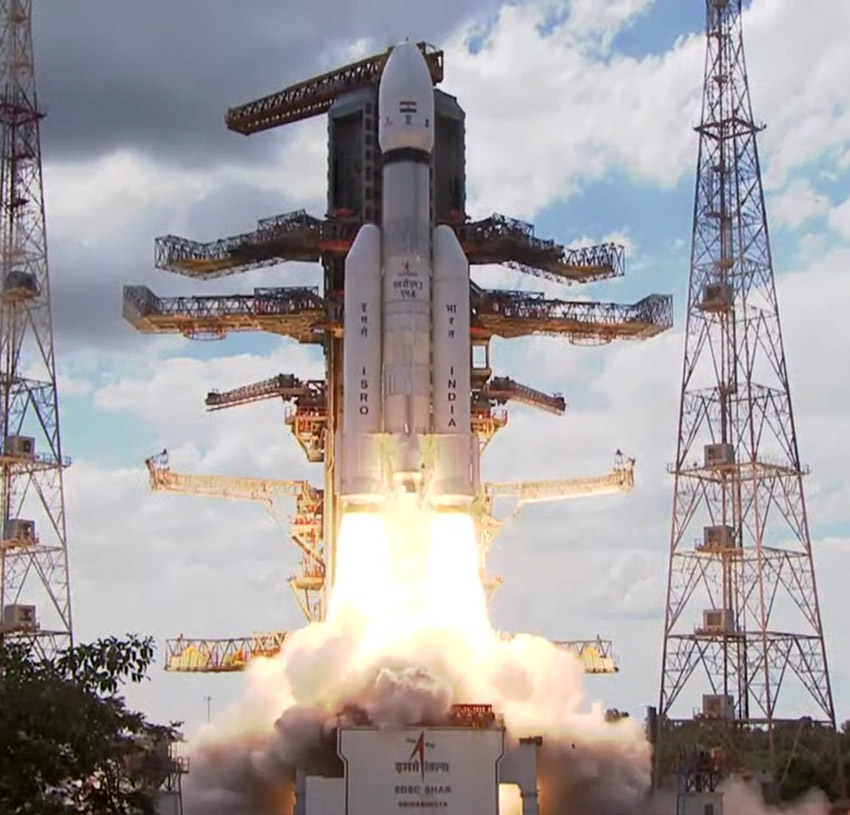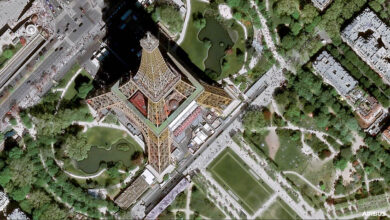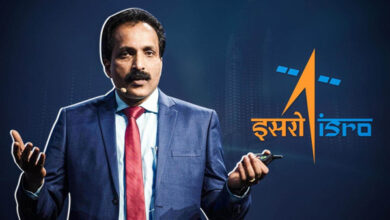Chandrayaan-3: Indian rocket LVM3 blasts into space for Moon mission, Satellite enters precise orbit
“Chandrayaan-3 scripts a new chapter in India’s space odyssey. It soars high, elevating the dreams and ambitions of every Indian. This momentous achievement is a testament to our scientists’ relentless dedication. I salute their spirit and ingenuity!”
— Prime Minister Narendra Modi.
Bangalore, July 14. India’s heavy lift rocket-LVM3 carrying the 3,897.89 kg Chandrayaan-3 spacecraft blasted off from the Sriharikota spaceport on July 14 afternoon. At about 2.35 p.m. the LVM3 rocket broke free from the second launch pad at the Satish Dhawan Space Centre (SDSC).

The 43.5 metre tall rocket weighing about 642 ton furiously rushed towards the skies with thick orange flame leaving behind a long and thick white smoke.
Chandrayaan-3 is India’s first major mission since Narendra Modi’s government unveiled policies to boost investment in space launches and related satellite-based businesses.
“India today embarked on its historic Space Journey with the successful launch of Chandrayaan-3. My Hearty Congratulations to ISRO Scientists whose tireless pursuit has today propelled India on the path of scripting a remarkable space odyssey for generations to Cherish.”
— Home Minister Amit Shah
Chandrayaan-2 failed to achieve the desired soft landing on the moon surface in 2019, leaving the ISRO team dejected. Images of an emotional then ISRO chief K. Sivan being consoled by Prime Minister Narendra Modi who was present to achieve the rare feat, remains vivid in the memory of many.
Chandrayaan-3, India’s third moon mission and its second attempt to make a soft lunar landing, took off successfully aboard the aboard the Launch Vehicle Mark 3 (LVM 3) rocket from the second launchpad of the Satish Dhawan Space Centre, Sriharikota.
Chandrayaan-3 mission is a follow-up to the second lunar mission. According to scientists involved in the project, Chandrayaan-3 should be able to handle the challenges better than the two missions that came before.
At the end of the countdown, the LVM3-M4 rocket lifted off majestically at the prefixed time. The lift-off was normal and smooth, ISRO said.
The stage separations were executed precisely as planned, it added.
ISRO announced the Chandrayaan-3 mission as accomplished after the satellite entered the orbit after an event-free flight.
Scientists at the Satish Dhawan Space Centre here, after investing many hours of hardwork, now aim at mastering the technology of soft-landing on the surface of the moon.
A success would make India only the fourth country to achieve the feat after the United States, China and the former Soviet Union.
“Moment of glory for India and moment of destiny for all of us here at Sriharikota, who are part of the history in the making. Thanks to Prime Minister Narendra Modiji for making this possible by unlocking and enabling India’s Space sector. Proud of you team ISRO.”
— Dr. Jitendra Singh, MOS for Science and Technology, (Independent Charge), and MOS, PMO
Chandrayaan-3 is the third lunar exploration mission takes off in the fourth operational mission (M4) of LVM3 launcher.
ISRO is crossing new frontiers by demonstrating soft-landing on the lunar surface by its lunar module and demonstrating roving on the lunar terrain, the space agency said.
The mission is expected to be supportive to future interplanetary missions.
ISRO scientists announce the successful separation of the Satellite from the launch Vehicle.
The Satellite has now been injected into the desired Orbit to begin its journey to the Moon.
LVM 3-M4 rocket has put Chandrayaan-3 into the precise orbit, says ISRO chief Somanath.
The 25.30-hour countdown for the lift off had commenced at 1.05 pm a day earlier.
ISRO said that it had conducted a review of the mission readiness ahead of the scheduled launch. The ‘Launch Rehearsal’ simulating the entire launch preparation and process was concluded earlier.
Chandrayaan-3 is equipped with a lander, a rover and a propulsion module. Its weight is about 3,900 kilograms.
After travelling 3.84 lakh km, the LVM 3 is scheduled for a lunar touchdown on August 23-24.
Once the success is achieved, Chandrayaan-3 will mark India’s entry into an elite club of countries comprising the US, Russia and China that have successfully accomplished lunar landings.
The mission has eight payloads in total. The Vikram lander carries 4 instruments, the Pragyan rover two, and Propulsion Module or the Orbiter carries one experiment.
The propulsion module along with the lander, after gaining speed would proceed for an over a month long journey towards reaching the orbit of the moon until it goes 100 km above the lunar surface.
After reaching the desired altitude, the lander module would begin its descent for a soft landing on the south-pole region of the moon and this action is expected to take place on August 23 or 24, scientists at ISRO said.
The Chandrayaan programme was first announced on August 15, 2003 by the then Prime Minister, the late AtalBihari Vajpayee.
“Chandrayaan-3 has started its journey towards the moon. Our dear LVM3 has already put Chandrayaan-3 craft into the precise around earth…Let us wish all the best for the Chandrayaan-3 craft to make its farther orbit raising manoeuvres and travel towards the moon in the coming days…”
— ISRO Chairman S. Somanath
The first mission, Chandrayaan-1, took off on October 22, 2008. After entering Lunar Transfer Trajectory as planned, the Moon impact probe ejected and crashed near the lunar South Pole. This mission confirmed the presence of water molecules on Moon’s surface. On August 28, 2009, the end of the first mission was announced by ISRO.
Chandrayaan-2, the second mission, was launched on July 22, 2019, entering lunar orbit on August 20, 2019. On September 2, 2019, the Vikram Lander was separated while orbiting the moon in a 100 kms lunar polar orbit. Relay from Vikarm to ground stations was lost at an altitude of 2.1 km from the lunar surface — a development that negatively impacted India’s credentials as a spacefaring power.
More than 10,000 people from Tamil Nadu, Andhra Pradesh and Karnataka arrived at Sriharikota since early morning to watch the D-Day unfold.
They were allowed to witness the launch from the dedicated space gallery set up by ISRO adjacent to the main entrance of the space centre.





